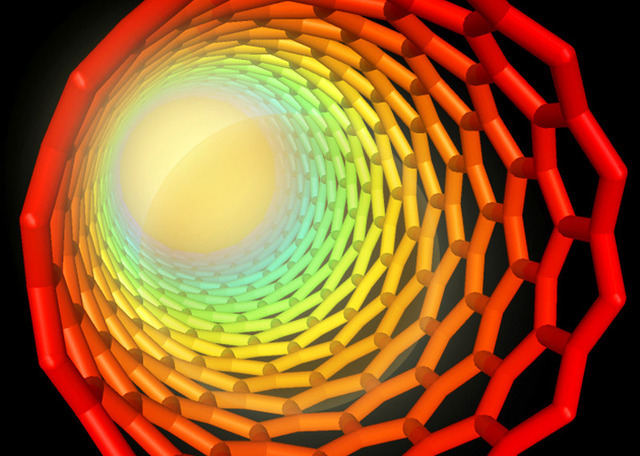
Since the 1970s, chemists have worked on storing solar energy in molecules that change state in response to light. These photoactive molecules could be the ideal solar fuel, as the right material should be transportable, affordable, and rechargeable. Unfortunately, scientists haven’t had much success. One of the best examples in recent years, tetracarbonly-diruthenium fulvalene, requires the use of ruthenium, which is rare and expensive. Furthermore, the ruthenium compound has a volumetric energy density (watt-hours per liter) that is several times smaller than that of a standard lithium-ion battery.
Alexie Kolpak and Jeffrey Grossman from the Massachusetts Institute of Technology propose a new type of solar thermal fuel that would be affordable, rechargeable, thermally stable, and more energy-dense than lithium-ion batteries. Their proposed design combines an organic photoactive molecule, azobenzene, with the ever-popular carbon nanotube.
Before we get into the details of their proposal, we’ll quickly go over how photoactive molecules store solar energy. When a photoactive molecule absorbs sunlight, it undergoes a conformational change, moving from the ground energy state into a higher energy state. The higher energy state is metastable (stable for the moment, but highly susceptible to energy loss), so a trigger—voltage, heat, light, etc.—will cause the molecule to fall back to the ground state. The energy difference between the higher energy state and the ground state (termed ΔH) is then discharged. A useful photoactive molecule will be able to go through numerous cycles of charging and discharging.
The challenge in making a solar thermal fuel is finding a material that will have both a large ΔH and large activation energy. The two factors are not always compatible. To have a large ΔH, you want a big energy difference between the ground and higher energy state. But you don’t want the higher energy state to be too energetic, as it would be unstable. Instability means that the fuel will have a small activation energy and be prone to discharging its stored energy too easily.
Kolpak and Grossman managed to find the right balance between ΔH and activation energy when they examined computational models of azobenzene (azo) bound to carbon nanotubes (CNT) in azo/CNT nanostructures. According to their calculations, placing azobenzene on carbon nanotubes will stabilize both the ground and higher energy states. There is a decent energy gap between the two states, meaning a good ΔH. Second, stabilizing the higher energy state means that the activation energy is large enough to give the photo-excited azo/CNT material a relatively long half life (over one year).
In terms of energy storage, the azo/CNT nanostructures outdo lithium-ion batteries. Kolpak and Grossman calculate that the azo/CNT system will have volumetric energy densities of about 690 watt-hours per liter; lithium-ion batteries range from 200 to 600 watt-hours per liter. For comparison, azobenzene alone has a volumetric energy density of only about 90 watt-hours per litter.
Kolpak and Grossman’s proposed azo/CNT system could be adapted for use with other photoactive molecules, as it appears that placing them on carbon nanotubes enhances their energy storage properties. This is perhaps the most important result from their work.
While Kolpak and Grossman have presented a promising new approach to making solar thermal fuels, there are potential drawbacks, and the fact that they haven't actually created the substance isn't even the most substantial. The energy stored in the azo/CNT system can only be released as heat. If you want to use the stored energy to power electrical devices, you would need to convert the heat to electricity. This adds a step that requires more equipment and can result in energy loss during the conversion.
Nano Letters, 2011. DOI: 10.1021/nl201357n (About DOIs)
Listing image by Photograph by Christine Daniloff, National Science Foundation
reader comments
74